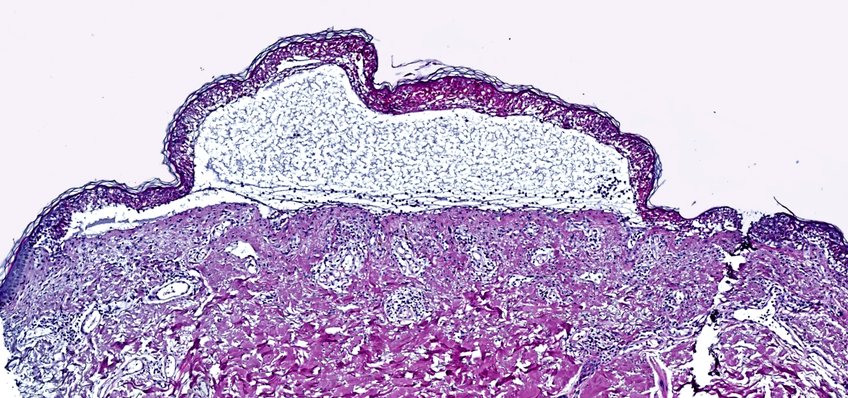New technology saves the lives of patients with fatal skin reactions
Spatial proteomics provides therapeutic approach for patients with toxic epidermal necrolysis
A global team of researchers at the Max Planck Institute of Biochemistry has made a groundbreaking discovery that saves the lives of patients suffering from toxic epidermal necrolysis. This rare but often fatal reaction to common medications causes widespread detachment of the skin. Using innovative spatial proteomics – one of the most advanced molecular biology tools – the team identified the inflammatory JAK/STAT pathway as the main driver of disease. After validating their findings in pre-clinical models, they successfully treated the first seven patients worldwide with JAK inhibitors, all of which showed rapid and full recovery.

The researchers used spatial proteomics to analyze skin samples from patients with toxic epidermal necrolysis. This cutting-edge approach, known as Deep Visual Proteomics, merges powerful microscopy with AI-driven analysis, laser-guided microdissection and ultimately ultra-high sensitivity mass spectrometry. They zoomed in on individual cells and studied them like never before, creating a map of the thousands of proteins driving this deadly reaction.
Thierry Nordmann, first author, clinician-scientist at the Max Planck Institute of Biochemistry and senior dermatologist at the Ludwig Maximilians Universität München explains: “By applying spatial proteomics to archived patient samples suffering from toxic epidermal necrolysis, we were able to precisely isolate and analyze individual cell types and understand what is actually occurring in the skin of these patients. We identified a striking hyperactivation of the inflammatory JAK/STAT pathway, revealing an opportunity to intervene in this deadly condition with JAK inhibitors, a class of drugs already used to treat other inflammatory conditions, such as atopic dermatitis or rheumatoid arthritis."
Toxic epidermal necrolysis is a rare but extremely severe adverse reaction to common medications, such as allopurinol (which is used to treat gout) or certain antibiotics. It causes widespread blistering and detachment of the skin. With a mortality rate of up to 30 percent, it rapidly transforms from a seemingly harmless rash into a life-threatening condition. Until now, no effective therapy existed, with treatment primarily limited to supportive care.
The team validated their findings across a variety of preclinical studies, including in vitro models and two distinct mouse models. The results were consistent and overwhelmingly positive: JAK inhibitors show real potential in treating this devastating condition. These discoveries were further strengthened by a global collaboration across six countries, demonstrating the power of partnership in solving urgent medical challenges.
A new therapy for patients?
In partnership with clinical teams led by Chao Ji at the First Affiliated Hospital of Fujian medical University in China, they administered JAK inhibitors to patients suffering from toxic epidermal necrolysis. Remarkably, all seven patients experienced rapid improvement and full recovery upon treatment.
Lars French, co-corresponding author and Chair of Dermatology at LMU Munich, says: "The new evidence that inhibition of the JAK/STAT pathway has potential to reduce the high mortality of this severe adverse cutaneous drug reaction paves the way for clinical trials aimed at regulatory approval of JAK inhibitors to solve one of the most serious unmet needs in medicine."
While larger clinical trials are needed to confirm the efficacy and safety of JAK inhibitors in toxic epidermal necrolysis, this study provides hope for patients facing this devastating condition. It also opens up new opportunities for drug repurposing and development. The Max Planck Society has filed patent applications together with the Ludwig Maximilian University for the use of JAK inhibitors in treating toxic epidermal necrolysis and related conditions, creating potential for further development.
"Our findings not only open new avenues for treating this reaction, but also highlight the potential of spatial proteomics in driving medical breakthroughs," says Matthias Mann. "To our knowledge, this is the first time a spatial omics technology has made an immediate and tangible impact in the clinic, by identifying a treatment that has already changed people's lives for the good. This approach could be applied to a wide range of diseases, potentially accelerating drug discovery across multiple fields of medicine."
Glossary
Deep Visual Proteomics: spatial proteomics method developed in the laboratory of Professor Matthias Mann. This method combines modern microscopy, artificial intelligence, laser microdissection and ultra-sensitive mass spectrometry.
JAK inhibitors: drugs that inhibit the JAK (Janus kinase) protein and thus block the JAK/STAT signaling pathway.
JAK/STAT signaling pathway: signaling pathway occurring in cells in which the JAK (Janus kinase) protein and the STAT protein (Signal Transducers and Activator of Transcription) are involved. This pathway is critical for various cellular processes, including inflammation, cell growth, and differentiation.
Mass spectrometry: analytical technique that separates and measures ions according to their mass-to-charge ratio to identify and quantify chemical substances or molecules. It is a cornerstone technology in proteomics, enabling the identification and quantification of thousands of proteins in complex biological samples.
Microdissection: microscopic procedure in which individual cells or groups of cells are cut out of a tissue section using a laser.
Omics technology: collective term for a group of methods in biotechnology and biology that enable the global analysis of biomolecules in biological systems. The methodology has the potential to show the overall context of biological systems. Common “omics” technologies are: Genomics: examines the entire genome, i.e., the entirety of DNA in a cell; Transcriptomics: analyzes the entire set of RNA molecules produced in a cell. Proteomics: examines the entire set of proteins produced by a cell or organism. Metabolomics: the study of all the metabolites in a cell and epigenomics: the study of all the epigenetic modifications in a genetic material.
Proteome: comprises the totality of all proteins in a living organism, a tissue or a cell at a specific point in time. The proteome is highly dynamic and reacts to the requirements of the cell, as well as to diseases or environmental influences.
Proteomics: study of the proteome.












